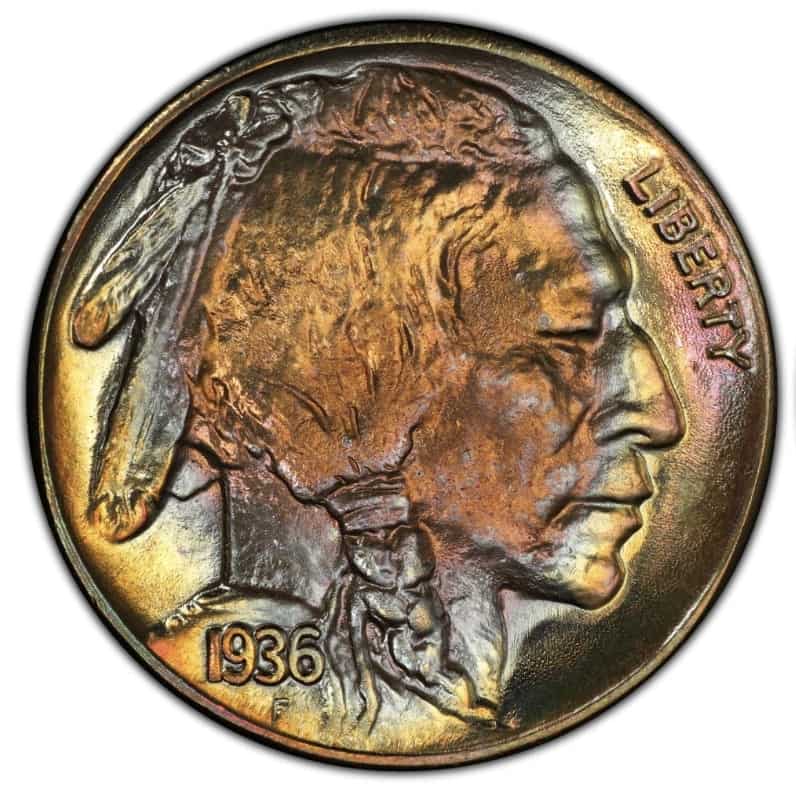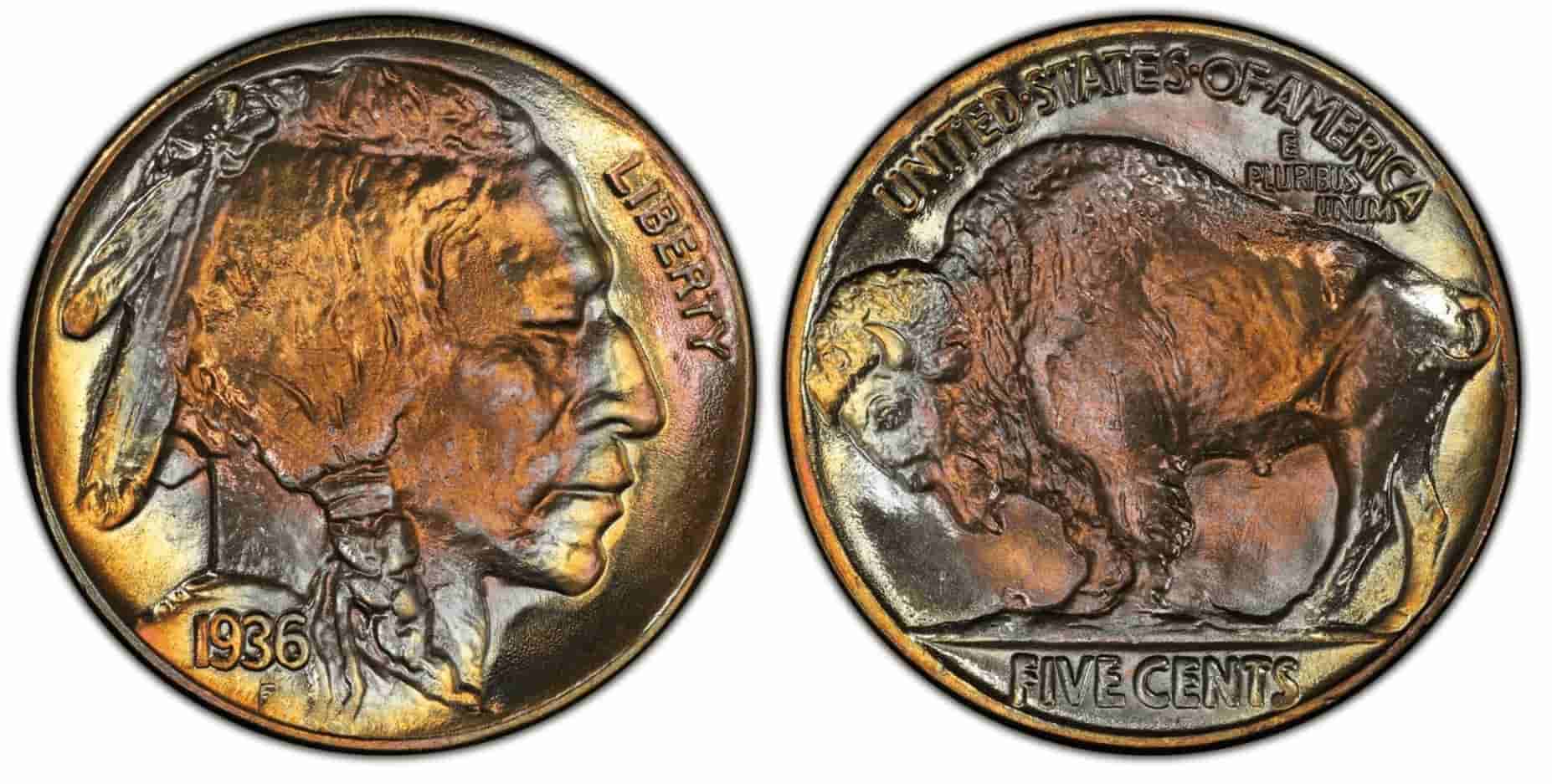How Much Is a 1936 Buffalo Nickel Worth?
Posted by Andrew Adamo on Jan 17th 2025
1936 Buffalo Nickel Value

The 1936 Buffalo Nickel value depends on its condition, mint mark, and any rare varieties. These iconic coins, also known as Indian Head Nickels, were minted in Philadelphia, Denver, and San Francisco. A 1936 Buffalo Nickel in circulated condition is often worth a few dollars, while uncirculated or proof examples can fetch significantly higher prices. Key features like a full, sharp strike on the buffalo’s horn can add to its value. Collectors also prize rare varieties, such as doubled die errors, from this year. Understanding the 1936 Buffalo Nickel value is essential for evaluating your collection or making informed trades.The 1936 Buffalo Nickel, minted during the Great Depression era, is one of the most popular and sought-after early nickels. 1936 Buffalo Nickel value can vary significantly based on its condition, mint mark, and any unique errors it may have.
- Circulated Condition: Typically worth under $5.
- Uncirculated Condition: Can range from $10 to $20, with exceptionally high-grade coins fetching even more.
- Mint Marks: The 1936 Buffalo Nickel was minted in Philadelphia (no mint mark), Denver (D), and San Francisco (S). Nickels with D or S mint marks tend to be more valuable, especially in higher grades.
- Value-Boosting Errors: Look out for rare errors like the 1936 "Doubled Die" variety, which can significantly increase the coin's value, sometimes reaching up to $3,000 or more depending on the condition.
Buffalo Nickel Coin Appearance and History
The Buffalo Nickel was actually the third official type of nickel, minted between 1913 and 1938. It replaced the Shield Nickel and the Liberty Head Nickel. Also called the Indian Head Nickel, this US coin was replaced by the Jefferson Nickel starting in 1938. It had the same face value as other nickels, but some of these valuable coins can be worth money far in excess of $0.05.
The Nickel was designed under the Teddy Roosevelt administration – a trend that would continue with descendants, such as Franklin D. Roosevelt, who commissioned coins like dimes and half-dollars. James Earle Fraser, one of the assistants of Augustus Saint-Gaudens, made the design, and he based it on several different models.
The Nickel’s obverse or head size features a Native American warrior’s head looking left. On the same side, the word “Liberty” is along the upper left-hand color along the side of the model’s nose.
Most coin collectors know that the year of minting should be on the lower right-hand side of the obverse side below the neckline, but it is worn off on most Buffalo Nickels found still in circulation. It’s possible to find these on a coin-collecting journey, but it might not be easy.
The reverse side, meanwhile, features the titular buffalo — but it's actually an American bison. The bison faces right, and, depending on the type you have, it will either be standing on a hill or on relatively flat ground.
What Is the 1936 Buffalo Nickel Coin Made Of?
The 1936 Buffalo Nickel coin isn’t made of silver, although it looks to be so on the surface. Instead, it is a clad coin made with 75% copper and 25% nickel alloy. Specifically, the copper is on the inside, and the nickel is on the outside to prevent wear and tear and degradation.
Nickel is also used for the exterior plating so that the Buffalo Nickel looks similar to the original 1972 half-dimes, which nickels were collectively invented to replace.
What Makes a 1936 Buffalo Nickel Rare?
There are a few different reasons why the 1936 Buffalo Nickel is considered to be rare. In that year, there was only a mintage of 100 million of these coins from the Philadelphia Mint. This is actually the highest for the entire series of 1936 Buffalo Nickels. In comparison, the San Francisco Mint only minted about 14 million coins, so it is one of the scarcer varieties of this coin.
Why this low mintage? It was most likely due to the depression. At the time of the 1936 Buffalo Nickel’s minting, the Great Depression was in full swing, and many people were financially struggling. Therefore, there was less of a need for excess nickels in circulation.
However, as noted above, exactly which mint a given coin came from can help to determine its overall rarity and value. A 1936 Buffalo Nickel from the Philadelphia Mint will be worth less compared to the same coin from the San Francisco Mint.
Buffalo Nickel Values and Mint Location
These days, you can find many different Buffalo Nickels with different values, key dates, and mint marks. The mint state factors heavily into the value. If you have a piece in a coin roll that you have questions about and want to sell, the PCGS and NCG can tell you more about its worth.
Here are the different varieties of Buffalo Nickels you might find, buy, or already have:
1936 D Buffalo Nickel
The 1936 D Buffalo Nickel was minted at the Denver Mint in Colorado. About 24 million of these coins were made, and many of them include different rarities or errors.
A non-error 1936 D Buffalo Nickel is worth about $1.13 if it receives a “good” grading. However, the highest known grade for these coins is only worth about $51 at auction.
1936 S Buffalo Nickel
Meanwhile, you’ll have much more value in your pocket if you get your hands on a 1936 S Buffalo Nickel. These nickels had the smallest overall run, clocking in at fewer than 15 million coins minted in total.
Still, most of these Buffalo Nickels run for $1.13. High-grade coins can be over $50. No proofs of these coins have been sold just yet, though that could change in the future.
1936 P Buffalo Nickel
The 1936 P Buffalo Nickel, also called the no mint markBuffalo Nickel, was very highly anticipated. There were about 120 million of these nickels made — the highest volume for any nickel coin ever. These coins are worth about $1 if they receive a good grade, with a maximum value of about $45 in MS 63.
Note that these coins were some of the first proofed Buffalo Nickels ever made. Those coins are valued much higher (see below).
1936 Proof Buffalo Nickel
“Proof” coins are early samples of a coin’s design and material composition, often used to compare minted varieties to ensure continuity and value. The US Mint struck two proofs of the 1936 Buffalo Nickel.
The first had a satin finish, and the second had a brilliant finish. Both varieties have roughly the same survivability, but the 1936 brilliant finish-proof nickel is a bit harder to find compared to the satin finish-proof nickel. Both are valued significantly more highly compared to other 1936 Buffalo Nickels, often being valued at between $1300 and $2500.
Error Coin Values
Like all valuable and rare coins, the 1936 Buffalo Nickel was occasionally produced with different errors that have only increased their collectors’ value.
Some of the most common errors you’ll find with this coin include:
- 1936 D Buffalo Nickel 3 and ½ legs error. This error counts as a variety because it was minted in very high volumes. Many mint workers over-polished one of the old dies used for these coins, brushing off half of the legs of the bison on the reverse side. These coins can be sold for as much as $22,000.
- 1936 DDO Buffalo Nickel. These coins feature double-dieobverse errors on the letters and numbers, resulting in typos or misprints of digits or letters. These can be worth between $50 and $1200, depending on grading and quality.
- 1936 DDR Buffalo Nickel error. These coins have an error on the reverse with a double die mistake. The legend can appear to be thicker at the top, and these coins can be worth anywhere between $100 and $1500 depending on the grading.
- 1936 Buffalo Nickel repunched mint mark (RPM) error #4. Coins with this unique error have their mint marks punched twice. Because these errors are fairly rare, coins with them are worth a lot; these particular varieties have been historically sold for over $500 and even close to $1000.
Find the Rare Nickels You’ve Been Looking For
No matter whether you have a Buffalo Nickel from Philadelphia, San Francisco, or elsewhere, it could be a collector’s piece and perhaps worth more than a mere five cents. But what if you don’t already have a Buffalo Nickel and are looking to complete your collection?
Bullion Shark can help. At our extensive shop, you can find the rare nickels you’ve been looking for all this time, plus check out other valuable coinage, ranging from historical American coins to ancient coins and more.
FAQ
How much is a 1936 Buffalo Nickel worth?
The value of a 1936 Buffalo Nickel depends on its condition. Circulated examples are typically worth around 50 cents to a few dollars, while uncirculated specimens with full details can fetch $20 or more.
Are there any rare versions of the 1936 Buffalo Nickel?
The standard 1936 Buffalo Nickels are not particularly rare. However, the 1936-D 3½ Legs variety is considerably rarer and more valuable, with prices often reaching several thousand dollars in good condition.
What makes the 1936 Buffalo Nickel special?
The 1936 Buffalo Nickel is special primarily because of its design, which is highly regarded for its depiction of Native American heritage and the American bison. Its high mintage also means it's readily available for collectors, making it a popular choice for beginning collectors.
How can I tell if my 1936 Buffalo Nickel is valuable?
Check for features like sharp and clear details, especially in the date, the bison’s fur, and the Native American’s profile. The coin's overall condition and any unique varieties, like the 1936-D 3½ Legs, can also make it more valuable.
What errors should I look for on a 1936 Buffalo Nickel?
Look for overdates, doubled dies, and any leg varieties, especially on the Denver minted coins (1936-D). These errors can significantly increase the nickel's value.
Where was the 1936 Buffalo Nickel minted?
The 1936 Buffalo Nickels were minted in Philadelphia (no mint mark), Denver (D), and San Francisco (S). The mint mark can be found below the denomination "FIVE CENTS" on the reverse.
What is the 1936-D 3½ Legs Buffalo Nickel?
This is a variety where part of the front leg of the bison appears worn away or weakly struck due to die abrasion or overpolishing by the Mint. This variety is rare and sought after by collectors.
How many 1936 Buffalo Nickels were made?
In 1936, the Philadelphia Mint produced approximately 119 million, the Denver Mint about 24.8 million, and the San Francisco Mint around 14.9 million Buffalo Nickels.
How should I store my 1936 Buffalo Nickel to maintain its value?
Store your Buffalo Nickel in a cool, dry environment. Use non-PVC coin holders, capsules, or albums to prevent damage from air and moisture.
Can a 1936 Buffalo Nickel still be used as currency?
While Buffalo Nickels remain legal tender, their potential collector value far exceeds their face value of five cents, making them impractical for everyday currency use.
Sources:
About | U.S. Mint
history on the buffalo nickel | Money.org
It's Bison, Not Buffalo. And Other American Bison Facts | Smithsonian's National Zoo
Learn more about: 1943 steel penny value, rare state quarters, rare pennies worth money list, Susan b Anthony coins, how many nickels in a roll, 1953 wheat penny value, quarters worth money, pennies worth money, 1942 penny value, what are nickels made of, most valuable quarters, 1945 wheat penny value, Morgan silver dollars, silver American eagles.



